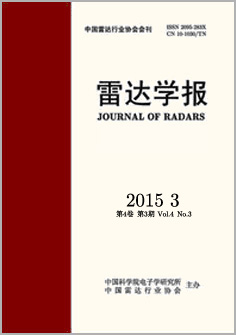| [1] |
Zuo L, Li M, Zhang X W, et al.. An efficient method for detecting slow-moving weak targets in sea clutter based on time-frequency iteration decomposition[J]. IEEE Transactions on Geoscience and Remote Sensing, 2013, 51(6): 3659-3672.
|
| [2] |
Chen X L, Guan J, Liu N B, et al.. Detection of a low observable sea-surface target with micromotion via the Radon-linear canonical transform[J]. IEEE Geoscience and Remote Sensing Letters, 2014, 11(7): 1225-1229.
|
| [3] |
Ward K D and Watts S. Use of sea clutter models in radar design and development[J]. IET Radar, Sonar Navigation, 2010, 4(2): 146-157.
|
| [4] |
闫亮, 孙培林, 易磊, 等. 基于逆高斯分布的复合高斯海杂波建模研究[J]. 雷达学报, 2013, 2(4): 461-465. Yan L, Sun P L, Yi L, et al.. Modeling of compound-Gaussian sea clutter based on an inverse Gaussian distribution[J]. Journal of Radars, 2013, 2(4): 461-465.
|
| [5] |
Zhang M, Chen H, and Yin H C. Facet-based investigation on EM scattering from electrically large sea surface with two-scale profiles: theoretical model[J]. IEEE Transactions on Geoscience and Remote Sensing, 2011, 49(6): 1967-1975.
|
| [6] |
Greco M, Stinco P, and Gini F. Identification and analysis of sea radar clutter spikes[J]. IET Radar, Sonar Navigation, 2010, 4(2): 239-250.
|
| [7] |
陈小龙, 关键, 何友. 微多普勒理论在海面目标检测中的应用及展望[J]. 雷达学报, 2013, 2(1): 123-134. Chen X L, Guan J, and He Y. Applications and prospect of micro-motion theory in the detection of sea surface target[J]. Journal of Radars, 2013, 2(1): 123-134.
|
| [8] |
Gutnik V G, Kulemin G P, and Sharapov L I. Spike statistics features of the radar sea clutter in the millimeter wave band at extremely small grazing angles[C]. The Fourth International Kharkov Symposium on Physics and Engineering of Millimeter and Sub-Millimeter Waves, Kharkov, Ukraine, 2001: 426-428.
|
| [9] |
Posner F L. Spiky sea clutter at high range resolutions and very low grazing angles[J]. IEEE Transactions on Aerospace and Electronic Systems, 2002, 38(1): 58-73.
|
| [10] |
梅孝安. IPIX雷达海尖峰统计特性研究[J]. 飞行器测控学报, 2007, 26(2): 19-23. Mei X A. A study on the statistical characteristics of IPIX radar sea spikes[J]. Journal of Spacecraft TT C Technology, 2007, 26(2): 19-23.
|
| [11] |
谢常清, 杨俊岭. 雷达海杂波尖峰时频分布特性研究[J]. 现代雷达, 2008, 30(5): 10-13. Xie C Q and Yang J L. A study on the time-frequency distribution of radar sea clutter spike[J]. Modern Radar, 2008, 30(5): 10-13.
|
| [12] |
Rosenberg L. Sea-spike detection in high grazing angle X-band sea-clutter[J]. IEEE Transactions on Geoscience and Remote Sensing, 2013, 51(8): 4556-4562.
|
| [13] |
Tao R, Zhang F, and Wang Y. Fractional power spectrum[J]. IEEE Transactions on Signal Processing, 2008, 56(9): 4199-4206.
|
| [14] |
Drosopoulos A. Description of the OHGR database[R]. Ottawa: DREO Technical Note, 1994.
|
| [15] |
Dong Y and Merrett D. Analysis of L-band multi-channel sea clutter[J]. IET Radar, Sonar Navigation, 2010, 4(2): 223-238.
|
| [16] |
Walker D. Doppler modelling of radar sea clutter[J]. IEE Proceedings-Radar, Sonar and Navigation, 2001, 148(2): 73-80.
|
| [17] |
Chen X L, Guan J, Huang Y, et al.. Maneuvering target detection via Radon-fractional Fourier transform-based long- time coherent integration[J]. IEEE Transactions on Signal Processing, 2014, 62(4): 939-953.
|
| [18] |
Chen X L, Guan J, Huang Y, et al.. Radon-linear canonical ambiguity function-based detection and estimation method for marine target with micromotion[J]. IEEE Transactions on Geoscience and Remote Sensing, 2015, 53(4): 2225-2240.
|
| [19] |
Guida M, Longo M, and Lops M. Biparametric CFAR procedures for lognormal clutter[J]. IEEE Transactions on Aerospace and Electronic Systems, 1993, 29(3): 798-809.
|




 Submit Manuscript
Submit Manuscript Peer Review
Peer Review Editor Work
Editor Work




 DownLoad:
DownLoad: